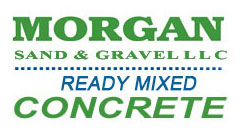General Information on Concrete
Subgrade Preparation
Cracks, slab settlement, and structural failure can often be traced to an inadequately prepared and poorly compacted subgrade. The subgrade on which a slab on ground is to be placed should be well drained, of uniform bearing capacity, level or properly sloped, and free of sod, organic matter, and frost. The three major causes of non-uniform support are (1) the presence of soft and hard spots, (2) backfilling without adequate compaction, and (3) expansive soils. Uniform support cannot be achieved be merely dumping granular material on a soft spot. To prevent bridging and settlement cracking, soft or mucky areas and hard spots (rocks) should be dugout and filled with soil similar to the rest of the subgrade or with granular material such as sand, gravel, or crushed stone. All fill materials must be compacted to provide the same uniform support at the rest of the subgrade.
Ordering Concrete
When placing your order, be prepared to give all necessary information such as name, address, directions to site, concrete mix and what is being poured (garage, basement, driveway, etc.) It is very import to tell Morgan Sand & Gravel personnel what you are pouring so that the proper mix is used for your application. Mention any possible restrictions or delays that may occur when the truck is at the site. Do not assume anything. Being informed and keeping our personnel informed will lead to a good end result.
Placing and Spreading
Placement should start at the far point and proceed toward the concrete supply source. The concrete, which should be placed as close as possible to its final position, should slightly overfill the forms and be roughly leveled with a square ended shovel or concrete rake. Using spaded shovel or garden rake is not recommended.
Strikeoff
Strikeoff is the process of cutting off excess concrete to bring the top surface of the slab to proper grade. There should be a very small amount of concrete against the front face of the straightedge to fill in low areas as the straightedge passes over the slab. Strikeoff should be completed before excess bleed water collects on the surface.
Bullfloating
To eliminate high and low spots and to embed large aggregate particles, a bullfloat should be used immediately after strikeoff. Bullfloating must be completed before bleed water accumulates on the surface. Care must be taken not to over work the concrete as this could result in a less durable surface. The preceding operations should level, shape, and smooth the surface and work up a slight amount of cement paste.
Troweling
Where a smooth, hard, dense surface is desired, floating should be followed by steel troweling. Timing for this procedure is critical. These operations should be delayed until after the concrete had hardened enough so that bleed water is not trapped just below the surface when finishing operations begin. To long of a delay will result in a surface that is too hard to float and trowel. The tendency, however, is to float the surface too soon. Premature floating and troweling can cause scaling, crazing, or dusting and will result in a surface with reduced wear resistance.
Curing is Key
Curing is one of the final, but vital, steps for a quality concrete product. Curing is ensuring that the concrete has enough moisture and the proper temperature to chemically react to bring your concrete to full strength. Curing greatly increases the strength and durability of concrete, and its resistance to freezing and thawing and deicer salts. If your concrete is not cured properly, you may end up with only 50% of the desired strength at the surface, which may not be strong enough to last through the winter. There are several methods of curing. The most common is the application of a compound sprayed onto the surface of the concrete immediately after finishing that prevents the concrete from drying prematurely. Concrete needs 30 days to properly cure under normal conditions. Under colder or wintry conditions, concrete needs a much longer time frame to reach its cured stage. Proper steps need to be taken to cure the concrete and to keep the concrete from freezing.
Sealing Your Concrete
Water repellent concrete sealers can help prevent surface defects from cold weather by keeping water from getting into the concrete slab. Applying a quality concrete sealer helps maximize protection and lengthens the time between applications. Cure and Seal sealers should be applied immediately after finishing procedures are completed. It also should be reapplied in 30 days to maximize protection. Always follow the manufacture's directions carefully.
Use Caution With Deicers
While concrete is the most durable product available for your home; proper care is a requirement for long lasting beauty and wear. One of the most damaging things to a new concrete surface is the use of delcers - especially the first winter. Concrete takes a while to reach full strength. While some deicers, such as salt, do not chemically react with the concrete, they increase the number of freeze / thaw cycles the concrete must go through. This has the potential of damaging the concrete before it can reach maximum strength. NEVER use deicers containing ammonium sulfate or ammonium nitrate. These chemicals are often packaged and sold as deicers but they will rapidly disintegration as well. After the first winter, deicing chemicals sodium chloride or calcium chloride may be used sparingly. Be cautious of products that claim to be "safe for use on concrete". Read the label to make sure that they do not contain ammonium sulfate or nitrates.
Finished Product
You will get many years of great service from your concrete by taking the proper steps and making the right decisions from beginning to end.
